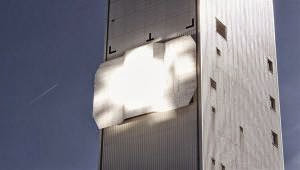The latest report of BWEA (British Wind Energy Association has stated that Wind Power is currently the fastest growing energy technology. They are aiming to have 5% of the UK's power requirements coming from onshore wind farms, by 2010. The UK Government is looking have another 10% of the energy coming from other renewable resources, by the same date. They are investing around 1lb billion in the wind farms.
Europe hopes to, by year 2020, be able to produce 20% of it's energy through renewable sources. German Government is looking to find other ways of reducing greenhouse gases outside wind farms. This is due to a report in 2005 where they stated that wind farms were expensive and inefficient.
There are also other elements of wind power energy that concern the government, such as the aesthetic aspect. The propellers also create a large amount of noise and are disruptive to the bird population.
However, new designs are being created to get around these issues. Viktor Jovanovic is one of these designers. He is busy created a model called the Stormblad Turbine [http://www.jovanovic.f2s.com/] which promises to deal with some of the problems. By designing it more to a jet engine the a propeller, it can operate in high winds, unlike the current model.
Terra Moya Aqua (TMA), based in Wyoming, is also working on a model, which is easier to operate and is quieter. This model is also free from ground resonance. They have been working on the design for the last 11 years, when Rasmussen, President of TMA, teamed up with Ron Taylor, TMA Chairman.
Both designs are smaller then the current model and focus on different problem areas. The other issue with Wind Power is that the power cannot be stored and is therefore unreliable. However Jovanovic thinks this will change in time, as new solutions are created.
Quite Revolution, based in the UK, is being bombarded for orders with their new design which is different from others so far. The model doesn't have to track round to catch the wind, plus the material it is made from makes the propeller more quite and creates more power.
GEV Wind Power, one of Europe's leading maintenance companies in the wind energy sector, will be exhibiting its cutting edge advancements in turbine blade maintenance at EWEA Offshore in Copenhagen on 10-12th March 2015.
GEV's innovative Habitat represents a major milestone in the maintenance of remote wind turbines, enabling engineers to complete essential works in a weather-protected environment. Whilst the simultaneous launch of a camera-based blade inspection service and GEV's own cloud based resource planning tool will help to further reduce operating costs.
The Habitat is expected to save the wind energy sector between three and five lost days in each maintenance season. It will also allow for work to continue beyond the standard May-October cycle, potentially returning a minimum of 1-2% increase in annual energy production.
Working collaboratively with Technology Partner Cornis, GEV is already offering clients the Panoblade Inspection System that rapidly captures images of an entire turbine blade surface.
Projects Director Alastair Gadney comments: "We recognised the cost effective and simple advantages of utilising the remote blade inspection system. With only one operator required to inspect up to five onshore turbines per day or three offshore turbines, this system will offer exceptional savings in both time and money."
To further drive down operating costs within the industry, GEV Wind Power has launched its own Blade ERP a tablet device that captures real-time activity to enable efficient data capture, reporting and invoicing.
Alastair added: "The fundamental advantage of the GEV Blade ERP is that it provides near real-time reporting on each maintenance job, thereby boosting efficiency and minimising errors generated during the manual processing of reports and invoices. Together with our Blade Habitat and remote blade inspection our aim is to continually bring innovation into the wind industry to play our part in driving down the cost of energy. "
GEV Wind Power is also the first contractor to be trained by BASF with the BASF RELEST(R) leading edge protection system. Wind turbine rotor blades are vulnerable to extreme erosion from the effects of wind, rain, snow, sand and UV radiation. RELEST Wind LEP is a protective two-part paint technology offering four times higher resistance than conventional solutions.
He continues: "Being part of the solution to this emerging issue was important to GEV and in the BASF RELEST we identified an effective market ready product. Erosion is going to become more and more important to wind farm operators and here again GEV Wind Power is at the very front of O&M providers. "
Located at stand C3-B52, visitors to the EWEA Offshore conference will have the opportunity to meet with GEV's managing director David Fletcher and Alastair Gadney who will be on hand to address sector specific questions and discuss GEV's innovations that are set to revolutionise the next generation of wind turbines.
Alastair concluded: "At GEV Wind Power, we endeavour to bring increased value within the supply chain. EWEA Offshore 2015 provides us with a perfect opportunity to meet with suppliers, manufacturers and developers to showcase our time and cost-saving innovations."
The show is the largest offshore wind energy conference and will bring together leading players from more than 50 countries, attracting more than 6,600 participants.
ENDS
For further information, interviews, or visuals, please contact:
Cat Kobylinski or Kate Bowden-Smith, Pier Marketing - 01394 276923
OR EMAIL CAT@PIER-MARKETING.COM
About GEV Group:
GEV Group is one of the UK's leading specialist engineering and access companies operating in the energy sector with business interests ranging from industrial coatings to subsea well control equipment maintenance. It is a market leader in the provision of field deployed rotor blade maintenance for the wind energy sector.
For further information, please visit:
www.gevgroup.com
www.gevwindpower.com
The post GEV Wind Power to present its cost-saving developments in turbine blade maintenance at EWEA 2015 appeared first on World Of Wind Energy.
In time, fossil fuels will soar in cost, partly because someday there will be a severe carbon tax, but also because there is only so much of it left. Peak Oil has been delayed, there is a goodly amount of coal left, certainly nasty tar sands and a lot of shale oil. The USA is the Saudi Arabia of shale. But well within a century, fossil fuels will become history. To the left, the sources of electricity. Unknown to many, most of the fossil fuels are at the bottom of the ocean as methane hydrates, my concern as the trigger for The Venus Syndrome.
"The problem with most renewable energy sources is the intermittency. Our Sun (energy produced by the fusion of hydrogen") is only effectively available for an average of 8 hours/day and our winds come and go. Plus, there are questions of something called Energy Returned from Energy Invested (EROI). As this heat comes from the Sun, you could say that both solar and wind energies are nuclear power. Energy storage makes sustainable resources more amenable, but the total cost factor argues for other options.
"Drill down to some distance and you will eventually encounter heat, which, by the way, comes from the radioactive decay of elements like uranium and thorium. Hot dry rock geothermal is, thus, intriguing. At 660 km (which is deeper than 400 miles") the temperature reaches 3000 F. While that is far too deep for current and future technology, Los Alamos National Laboratory researchers have speculated that there is 300 times more accessible ("down to a little more than 5 miles") geo-energy than all the fossil fuels still available. Keep an eye on this pathway, but don't hold your breath.
"About ocean power, I long ago dismissed tidal, current, salinity gradients and wave resources as viable for mega-applications (certainly, here and there with exceptional natural conditions, a few sites will be commercialized") for a variety of reasons. Like geothermal, ocean thermal energy conversion (OTEC) is base load, and has the potential to equal the current usage of energy in the world. I will cover this promise in a later posting on the Blue Revolution.
So what about nuclear power? As you know, there are two different kinds:
"
* fission (which depends on the splitting of large atoms like from Uranium and Plutonium--or, the Atomic Bomb"): this is the process used by all commercial nuclear facilities today
"
* fusion (fuses small elements, like Hydrogen--think Hydrogen Bomb--yes, this is the much bigger bomb, but think of the potential for peace--plus it's much cleaner")
* our Sun and all stars generate heat through fusion
* on Earth, scientists are tinkering with magnetic confinement ("ITER in France)" and inertial confinement (Lawrence Livermore National Laboratory): I cannot report on anything optimistic today, but the future of Humanity will depend on success here
* then there is Lockheed Martin's compact fusion machine
* there is also a concept called Cold Fusion, where the reaction occurs at room temperature, as compared to 15 million degrees C in our Sun, 150 million C for ITER and 100 million C for laser fusion, and here is just one opinion:
"Cold fusion with palladium requires heavy water (deuterium oxide). Cold fusion with nickel appears to work as well with ordinary water as with heavy water. I expect nickel will become the dominant cathode material, in which case the fuel cost will be as close to zero as any fuel imaginable. Even heavy water fuel would be cheap. Heavy water costs about 1000 per kilogram retail, even though it is ubiquitous (it is 1 part in 6000 in every drop of water on earth). It is expensive because a lot of energy is required to separate it from ordinary water, and because demand is limited, so new separation technologies have not been developed.6 But you get a fantastic amount of energy out of a fusion reaction. Even at 1000 per kilogram, heavy water would be thousands of times cheaper than oil. In a heavy water cold fusion economy, a fraction of a percent of the fuel would have to be recycled to keep the heavy water separation plants working, whereas today 7% of oil goes to refinery use and loss.7 There are some indications that the cathode metal itself plays a role in the reaction. It may be transmuted, in which case it would be used up. A cold fusion reactor may require new metal from time to time, the way a fission reactor requires new uranium. Palladium and nickel are cheaper than uranium, and all three produce energy cheaper than oil does."
So let's return to today and you could have missed this piece of news, but the 42-year old 600 MW Yankee nuclear power plant in Vermont, with Federal approval to operate for 17 more years, quietly shut down for good yesterday. Just this facility had provided 70% of all the electricity generated in Vermont since 1972. There was no danger to the community. It was just too expensive to operate. The average age of a U.S. commercial nuclear reactor is 32 years.
"Could this be an end to the fission nuclear era? Probably not, as the Tennessee Valley Authority Watts Bar 2 (WB 1 came on line in 1996") nuclear generation unit is a year away from operation, and five more are on track for powering up by 2020, all in the South.
According to World Nuclear Association:
NUCLEAR POWER IN THE USA
"(Updated November 2014)"
* THE USA IS THE WORLD'S LARGEST PRODUCER OF NUCLEAR POWER, ACCOUNTING FOR MORE THAN 30% OF WORLDWIDE NUCLEAR GENERATION OF ELECTRICITY.
* THE COUNTRY'S 100+ NUCLEAR REACTORS PRODUCED 822 BILLION KWH IN 2013, OVER 19% OF TOTAL ELECTRICAL OUTPUT. THERE ARE NOW 100 UNITS OPERABLE AND FIVE UNDER CONSTRUCTION.
* FOLLOWING A 30-YEAR PERIOD IN WHICH FEW NEW REACTORS WERE BUILT, IT IS EXPECTED THAT SIX NEW UNITS MAY COME ON LINE BY 2020, FOUR OF THOSE RESULTING FROM 16 LICENCE APPLICATIONS MADE SINCE MID-2007 TO BUILD 24 NEW NUCLEAR REACTORS.
* HOWEVER, LOWER GAS PRICES SINCE 2009 HAVE PUT THE ECONOMIC VIABILITY OF SOME EXISTING REACTORS AND PROPOSED PROJECTS IN DOUBT.
* GOVERNMENT POLICY CHANGES SINCE THE LATE 1990S HAVE HELPED PAVE THE WAY FOR SIGNIFICANT GROWTH IN NUCLEAR CAPACITY. GOVERNMENT AND INDUSTRY ARE WORKING CLOSELY ON EXPEDITED APPROVAL FOR CONSTRUCTION AND NEW PLANT DESIGNS.
So we it is clear that fission nuclear power is making a renaissance. Prime Minister Shinzo Abe will do everything he can to restore as many of the 50 nuclear facilities in Japan as he can, and, frankly, those units are available, so why not use them as a bridge to their future?
Tomorrow, or so, I will present Part 2B: The Ultimate Energy System. I can provide a hint of what this will be:
* I worked for Edward Teller at the Lawrence Livermore National Laboratory on nuclear fusion.
* In 1989 I hired possibly the first cold fusion expert at any academic institution when I was director of the Hawaii Natural Energy Institute at the University of Hawaii.
* I wrote the original legislation in the U.S. Senate for hydrogen.
-





















